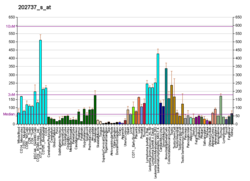| LSM4 | |||||||||||||||||||||||||||||||||||||||||||||||||||
|---|---|---|---|---|---|---|---|---|---|---|---|---|---|---|---|---|---|---|---|---|---|---|---|---|---|---|---|---|---|---|---|---|---|---|---|---|---|---|---|---|---|---|---|---|---|---|---|---|---|---|---|
| |||||||||||||||||||||||||||||||||||||||||||||||||||
| Identifiers | |||||||||||||||||||||||||||||||||||||||||||||||||||
| Aliases | LSM4, GRP, YER112W, LSM4 homolog, U6 small nuclear RNA and mRNA degradation associated | ||||||||||||||||||||||||||||||||||||||||||||||||||
| External IDs | OMIM: 607284; MGI: 1354692; HomoloGene: 134555; GeneCards: LSM4; OMA:LSM4 - orthologs | ||||||||||||||||||||||||||||||||||||||||||||||||||
| |||||||||||||||||||||||||||||||||||||||||||||||||||
| |||||||||||||||||||||||||||||||||||||||||||||||||||
| |||||||||||||||||||||||||||||||||||||||||||||||||||
| |||||||||||||||||||||||||||||||||||||||||||||||||||
| |||||||||||||||||||||||||||||||||||||||||||||||||||
| Wikidata | |||||||||||||||||||||||||||||||||||||||||||||||||||
| |||||||||||||||||||||||||||||||||||||||||||||||||||
U6 snRNA-associated Sm-like protein LSm4 is a protein that in humans is encoded by the LSM4 gene.
Sm-like proteins were identified in a variety of organisms based on sequence homology with the Sm protein family (see SNRPD2; MIM 601061). Sm-like proteins contain the Sm sequence motif, which consists of 2 regions separated by a linker of variable length that folds as a loop. The Sm-like proteins are thought to form a stable heteromer present in tri-snRNP particles, which are important for pre-mRNA splicing.
References
- ^ GRCh38: Ensembl release 89: ENSG00000130520 – Ensembl, May 2017
- ^ GRCm38: Ensembl release 89: ENSMUSG00000031848 – Ensembl, May 2017
- "Human PubMed Reference:". National Center for Biotechnology Information, U.S. National Library of Medicine.
- "Mouse PubMed Reference:". National Center for Biotechnology Information, U.S. National Library of Medicine.
- Salgado-Garrido J, Bragado-Nilsson E, Kandels-Lewis S, Seraphin B (Aug 1999). "Sm and Sm-like proteins assemble in two related complexes of deep evolutionary origin". EMBO J. 18 (12): 3451–62. doi:10.1093/emboj/18.12.3451. PMC 1171424. PMID 10369684.
- Achsel T, Brahms H, Kastner B, Bachi A, Wilm M, Luhrmann R (Dec 1999). "A doughnut-shaped heteromer of human Sm-like proteins binds to the 3'-end of U6 snRNA, thereby facilitating U4/U6 duplex formation in vitro". EMBO J. 18 (20): 5789–802. doi:10.1093/emboj/18.20.5789. PMC 1171645. PMID 10523320.
- ^ "Entrez Gene: LSM4 LSM4 homolog, U6 small nuclear RNA associated (S. cerevisiae)".
Further reading
- Singer J, Roberts-Ems J, Luthardt FW, Riggs AD (1980). "Methylation of DNA in mouse early embryos, teratocarcinoma cells and adult tissues of mouse and rabbit". Nucleic Acids Res. 7 (8): 2369–85. doi:10.1093/nar/7.8.2369. PMC 342390. PMID 523320.
- Friesen WJ, Dreyfuss G (2000). "Specific sequences of the Sm and Sm-like (Lsm) proteins mediate their interaction with the spinal muscular atrophy disease gene product (SMN)". J. Biol. Chem. 275 (34): 26370–5. doi:10.1074/jbc.M003299200. PMID 10851237.
- Hu RM, Han ZG, Song HD, et al. (2000). "Gene expression profiling in the human hypothalamus-pituitary-adrenal axis and full-length cDNA cloning". Proc. Natl. Acad. Sci. U.S.A. 97 (17): 9543–8. Bibcode:2000PNAS...97.9543H. doi:10.1073/pnas.160270997. PMC 16901. PMID 10931946.
- Eystathioy T, Peebles CL, Hamel JC, et al. (2002). "Autoantibody to hLSm4 and the heptameric LSm complex in anti-Sm sera". Arthritis Rheum. 46 (3): 726–34. doi:10.1002/art.10220. PMID 11920408.
- Strausberg RL, Feingold EA, Grouse LH, et al. (2003). "Generation and initial analysis of more than 15,000 full-length human and mouse cDNA sequences". Proc. Natl. Acad. Sci. U.S.A. 99 (26): 16899–903. Bibcode:2002PNAS...9916899M. doi:10.1073/pnas.242603899. PMC 139241. PMID 12477932.
- Ingelfinger D, Arndt-Jovin DJ, Lührmann R, Achsel T (2003). "The human LSm1-7 proteins colocalize with the mRNA-degrading enzymes Dcp1/2 and Xrnl in distinct cytoplasmic foci". RNA. 8 (12): 1489–501. doi:10.1017/S1355838202021726. PMC 1370355. PMID 12515382.
- Lehner B, Sanderson CM (2004). "A Protein Interaction Framework for Human mRNA Degradation". Genome Res. 14 (7): 1315–23. doi:10.1101/gr.2122004. PMC 442147. PMID 15231747.
- Gerhard DS, Wagner L, Feingold EA, et al. (2004). "The Status, Quality, and Expansion of the NIH Full-Length cDNA Project: The Mammalian Gene Collection (MGC)". Genome Res. 14 (10B): 2121–7. doi:10.1101/gr.2596504. PMC 528928. PMID 15489334.
- Fürst J, Schedlbauer A, Gandini R, et al. (2005). "ICln159 folds into a pleckstrin homology domain-like structure. Interaction with kinases and the splicing factor LSm4". J. Biol. Chem. 280 (35): 31276–82. doi:10.1074/jbc.M500541200. PMID 15905169.
- Rual JF, Venkatesan K, Hao T, et al. (2005). "Towards a proteome-scale map of the human protein-protein interaction network". Nature. 437 (7062): 1173–8. Bibcode:2005Natur.437.1173R. doi:10.1038/nature04209. PMID 16189514. S2CID 4427026.
- Yang ZQ, Streicher KL, Ray ME, et al. (2007). "Multiple interacting oncogenes on the 8p11-p12 amplicon in human breast cancer". Cancer Res. 66 (24): 11632–43. doi:10.1158/0008-5472.CAN-06-2946. PMID 17178857.
- Ewing RM, Chu P, Elisma F, et al. (2007). "Large-scale mapping of human protein–protein interactions by mass spectrometry". Mol. Syst. Biol. 3 (1): 89. doi:10.1038/msb4100134. PMC 1847948. PMID 17353931.
This article on a gene on human chromosome 19 is a stub. You can help Misplaced Pages by expanding it. |





